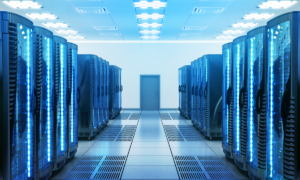Introduction
The combination of Artificial Intelligence (AI) and Robotics is transforming industries by enabling autonomous, adaptive, and highly efficient systems. In optical networking, AI-powered robotics is revolutionizing fiber infrastructure automation, dynamic interconnect management, and predictive maintenance. This fusion is not only enhancing network performance but also reducing human errors, operational costs, and downtime.
Beyond networking, AI-driven robotics is impacting data centers, manufacturing, logistics, and even agriculture, enabling a new era of self-managing, intelligent machines.
Key Applications of AI + Robotics in Optical Networking
1. AI-Powered Robotic Patch Panels
- Automates physical fiber connections using robotic arms and actuators.
- AI analyzes network traffic and suggests optimal fiber routing configurations.
- Reduces reliance on manual labor and enables remote, zero-touch provisioning.
✅ Example:
- Telescent’s AI-driven robotic fiber switch can autonomously manage thousands of fiber connections, optimizing data center interconnects without human intervention.
2. Autonomous Optical Cable Deployment & Maintenance
- AI-powered robots can lay fiber optic cables in harsh environments (underwater, underground, or in space).
- Self-navigating robotic systems use AI to analyze terrain and optimize fiber deployment routes.
- Reduces costs and speeds up fiber-to-the-home (FTTH) and 5G backhaul rollouts.
✅ Example:
- Verizon’s AI-driven fiber installation robots are automating 5G fiber deployment in metro areas, reducing installation times by 40%.
3. AI-Driven Optical Fault Detection & Self-Healing Networks
- AI-powered robotic inspection drones scan fiber networks for physical damage, fiber cuts, and degradation.
- AI algorithms predict potential failures and automatically dispatch robotic repair units.
- Self-healing networks can reroute traffic in real-time, minimizing downtime.
✅ Example:
- AT&T’s AI-integrated fiber drones monitor aerial fiber routes, using computer vision and ML models to detect and repair faults before outages occur.
4. AI-Augmented All-Optical Switching & SDN
- AI and robotics enable automated, real-time switching of optical signals, removing the need for human intervention.
- Optical networks powered by AI and software-defined networking (SDN) dynamically adjust fiber interconnects based on traffic demands.
- Reduces network congestion and latency while maximizing bandwidth efficiency.
✅ Example:
- IBM’s AI-powered optical switches optimize hyperscale data centers, reducing power consumption by up to 50% compared to traditional electrical switches.
AI + Robotics Beyond Optical Networking
1. AI-Driven Robotics in Data Centers
- AI-controlled robotic arms optimize data center airflow and cooling, reducing energy costs.
- Automated hardware replacement bots swap out faulty servers and components.
- AI predicts server failures and dispatches robots to proactively replace parts.
✅ Example:
- Google’s DeepMind AI optimizes cooling in its data centers, reducing power consumption by 40%.
2. AI-Powered Autonomous Warehouse & Logistics Robots
- AI robots optimize warehouse storage, picking, and packing operations.
- Robotics integrated with computer vision and reinforcement learning adapts to changing inventory.
- Reduces human labor in fulfillment centers and supply chains.
✅ Example:
- Amazon’s Kiva robots use AI to navigate massive fulfillment centers, improving order processing speed by 300%.
3. AI & Robotics in Agriculture (AgTech)
- Autonomous farming robots use AI to monitor soil conditions, plant health, and irrigation.
- AI-powered drone swarms scan large farms, identifying pests and applying targeted treatments.
- Reduces water, pesticide, and fertilizer waste, improving sustainability.
✅ Example:
- Dan Dan Farm’s AI-enhanced olive oil production integrates data-driven robotic monitoring to optimize yield and quality.
4. AI-Driven Robotics in Manufacturing
- AI-powered cobots (collaborative robots) work alongside humans in factories, enhancing precision and efficiency.
- Uses AI-powered predictive maintenance to prevent machinery failures before they occur.
- Adaptive automation enables mass customization in smart factories.
✅ Example:
- Tesla’s AI-driven robotic assembly lines adjust in real-time to produce customized EV models efficiently.
The Future of AI + Robotics
1. Fully Autonomous Optical Networks
- AI + Robotics will create self-configuring fiber networks, removing manual intervention entirely.
- AI will optimize bandwidth in real-time, ensuring maximum efficiency for 800G and 1.6T optical networks.
2. AI-Powered Humanoid Technicians
- Advanced AI-driven humanoid robots will replace network engineers for routine physical maintenance.
- These bots will identify, repair, and reconfigure fiber networks with near-zero error rates.
3. AI & Robotics in Space-Based Fiber Networks
- AI-controlled robotic satellites will deploy and maintain optical communication networks in space.
- Enables low-latency global fiber-optic connectivity using AI-optimized orbital routing.
✅ Example:
- SpaceX’s AI-optimized Starlink laser interconnects are a step toward AI-managed space-based optical fiber networks.
Conclusion
The convergence of AI and robotics is driving the next revolution in optical networking, data centers, and automation-heavy industries. By eliminating human error, improving efficiency, and enabling self-optimizing systems, AI-powered robots will reshape the future of connectivity and automation.











